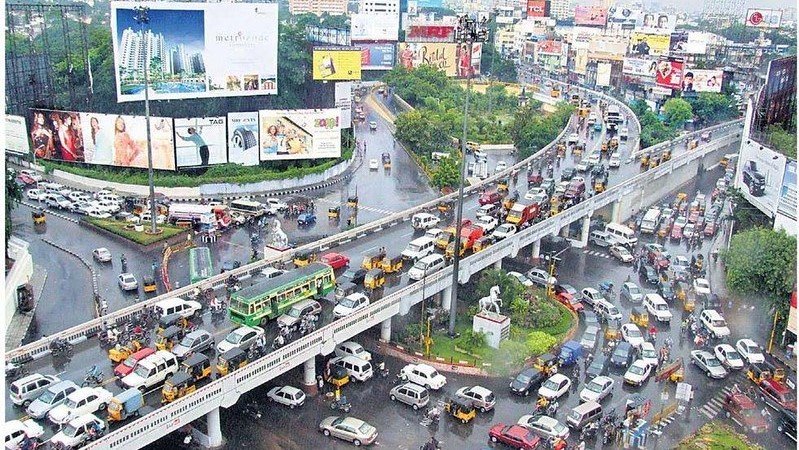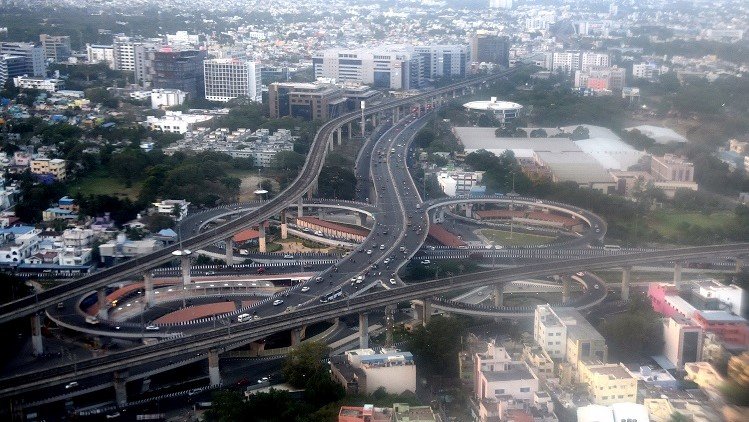Read in : தமிழ்
Soon after assuming office, the DMK government rekindled its love for flyovers, announcing several of these structures for important road stretches, including Anna Salai and Poonamallee. Just one stretch, from Teynampet to Saidapet covering 3.2 km, is to get an outlay of Rs.485 crore, as per the initial announcement.
These costly ‘super roads’ that will tower over the familiar terrain of the city, scarring the visual landscape, may be deferring to giant construction interests. Although the government under Chief Minister M.K. Stalin wants to shift to a new paradigm and re-envision future development in Tamil Nadu, it has found it difficult to shake off entrenched forces favouring business-as-usual on urban planning and development. Even the report of the Tiruppugazh Committee on the 2021 flood and remedies is not traceable on the Internet.
Flyovers are obviously and unabashedly designed to support private car use. If big, shiny cars are a symbol of material success today, flyovers are visible, indelible marks of political presence. The urban planning critique of Mumbai points to political support for flyovers at a specific inflection point, with Nitin Gadkari, as PWD Minister in the 1995 Sena-BJP government plunging into flyover-building in Maharashtra’s capital, although few of these had any real value in freeing up traffic.
In Chennai, the inadequacy of flyovers as decongestion solutions is painfully evident at Gemini. The Anna flyover here which opened in 1973 – arguably one of the better designed – has, over the years, routinely seen a traffic-pile up during peak hours stretching up to a kilometre on either side. On the Thousand Lights end, the traffic police have been grappling for years with the problem of the chicken neck, as vehicles pour down from the flyover and crowd Peters Road junction, simply because there is too little space for everyone to manoeuvre. It is common knowledge that Chennai’s vehicle base has exploded and the problem is bound to rise as towering buildings add to density.
The 10 flyovers built during the 1990s by the DMK government have produced mixed results, generating several problems that did not exist earlier. These include flooding of areas at the base of the structure (as in Mahalingapuram – T.Nagar) because flyovers turn into funnels bringing a large amount of water – and drains are overwhelmed. Eroded roads lie pitted and torn and there are no repairs for weeks. This slows down rather than speed up traffic.
Unnecessary and steep flyovers, such as the one in Doveton add to fuel cost because there is both a gradient and the resulting extra distance to be covered. These flyovers are narrow for heavy vehicles like buses, involving sharp turns, raising safety concerns. Limited-use small flyovers do not support buses, making them totally public-sponsored facilities for car owners. They pay nothing extra to use them multiple times. By contrast, a passenger must pay a stiff fare to use the Chennai Metro every time, although the facility is being paid for by the taxpayer.

In Chennai, the inadequacy of flyovers as decongestion solutions is painfully evident at Gemini. Photo Credit : Chennai-Gemini Flyover by Azhagu2011- Flickr
Why flyovers don’t always work
As the celebrated urban planning activist Jane Jacobs said in her book The Death and Life of Great American Cities, the vital organs of a city are its streets and sidewalks (or footpaths as we call them). Flyovers disconnect a large number of people from the ground reality, and the space below them is often left neglected, with small or unusable sidewalks or none at all. The G.N. Chetty Road flyover is so badly designed that buses using the road below have a nightmare avoiding a collision. It is, therefore, common to find flyover proponents coming up with “beautification” plans, and the present government has started developing these blind spots, as in the Kathipara cloverleaf, as recreational centres.
Among the worst hit due to poorly designed flyovers are pedestrians and users of public transport. The mega structure at Vadapalani straddling Arcot Road towards Koyambedu is a classic. Before it appeared on the scene, it was possible for bus users to have convenient stops near the Vadapalani junction. But many MTC routes now stop after the flyover, well after SIMS hospital, necessitating a difficult walk back, amidst heavy road traffic. Crossing the wide Inner Ring Road also involves trekking to the Vadapalani junction, since the long flyover has no crossing points below.
No help to shops either
Flyovers create dead zones beneath, since the pre-existing businesses and shops alongside suddenly lose both their visibility and attractiveness. This holds good for subways (underpasses) too, such as Duraiswamy and Aranganathan subways in T.Nagar. If car users no longer notice these businesses because they are “flying over”, the neglect of the roads below leaves them dark, decrepit, uneven and hostile for pedestrians. There is little space to enter and exit, as the roads are already narrow and shrunken by the flyover structures.
Memorably, when there was severe criticism that the flyovers on Peters Road in Royapettah and TTK Road in Alwarpet did not provide for pedestrian needs below, Stalin, who was the mayor then, lamented that people were not using pavements even where they were available.
Residents of Adyar who find little value in the flyover there have told the media that as per traffic police data, 40 people have died in accidents since the structure came up, many of them trying to cross the road under highly risky conditions. Even if the figures are unconfirmed, the macabre phenomenon is true anecdotally. How will new flyovers avoid this?
Go back to drawing board
These are mistakes from which there is much to learn. Rather than commit hundreds of crores to flyovers announced without adequate public consultation, the government should go back to the drawing board and call for ideas to decongest the city.
The two prongs to less stressful Chennai roads have to be: big expansion of rail-bus-last mile connectivity and road pricing for private vehicles. Creating more priced interior parking lots is urgently called for. This will help both motorist and pedestrian, and decongest the road. As these columns have pointed out earlier, they also represent untapped revenue. T. Nagar’s crowded jewellery shops have adopted this model by design, buying up adjacent properties and turning them into parking lots for customers. The Corporation and PWD can do better, turning suitable poramboke land and government grounds into paid parking lots.
It is not as if flyovers are a DMK preserve. When the present Health Minister, M. Subramaniam criticised the Jayalalithaa government in the Assembly for not doing enough to decongest Chennai, the AIADMK members led by Edapadi Palaniswami took credit for five new overbridges, ten minor bridges and three subways they had initiated. The DMK, which faced Jayalalithaa’s ire in the form of the “flyover scam” case in July 2001 and endured the arrest of Karunanidhi and others, is at a crossroads on urban planning. It has the opportunity to stop Chennai’s headlong hyper-motorisation and gentrification and come to the rescue of people, rather than cars. But does it have the stomach to overturn special interests who are influencing policy?
Read in : தமிழ்
